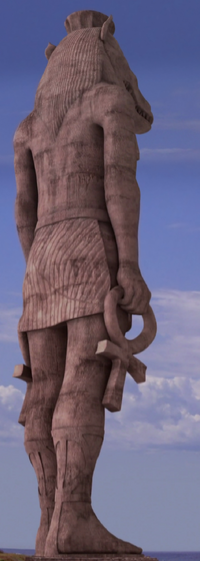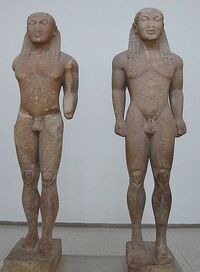| Main Article | Theories about Statue of Taweret/Theories |
Main Discussion |
| Theories may be removed if ... |
|---|
See the Lostpedia theory policy for more details. |
The statue might have belonged to an ancient civilization of whom the Others are a part or from whom they are descended. Ideas for the origin of the statue have resulted from the style and iconography of its appearance. There is no evidence that points to a definite theory.

Statue of Taweret as seen in The Incident, Parts 1 & 2

Kouros from the city of Delphi, ca. 580 BCE. These free-standing statues are known to be similar to earlier Egyptian statues. Notice the similar posture to that of the statue on the Island.
Egyptian[]
The statue was built by Egyptians.
Evidence[]
- On the Official Lost Audio Podcast Episode 6.15, Damon Lindelof let is slip that the statue "was built by the Egyptians". Carlton Cuse seemed surprised or caught off-guard that he stated this fact.
- The statue is wearing a shendyt and nemes, both Egyptian articles of clothing.
- The statue is holding an ankh in each hand. The ankh is an Egyptian symbol.
- The statue is in the classic Egyptian power stance used in their ancient statues (Legs locked, fists clenched, head forward, left foot forward)
- Evidence of Egyptian influence on the island can be seen in numerous venues
- Taweret is an Egyptian godess.
- Hieroglyphs
- Hurley’s sphinx drawing
- Egyptian deities represented under The Temple Wall.
- Many Egyptian deities are represented with 4 toes.
Counter-evidence[]
- Giant stone architecture comes after the development of Egyptian iconography; that is, the earliest depictions of this type of god vastly predate massive stone work like this, which replaced earlier mud brick work.
The ancient Egyptians did not have the ability to sail to the island.
Refutation of Counter-evidence[]
- The Egyptians would still use their iconography for art forms that arose later.
- If the island moves sporadically, the possibility that it was at one point in the Mediterranean, ostensibly close enough that the Egyptians could sail to it without special technology, is not that unlikely.--Master Tej (talk) 02:22, December 9, 2013 (UTC)
The "Sea People" from ancient history[]
The "Sea People" are an unknown group of people from ancient history who for over a hundred years attacked basically all of western civilization (Greece's Dark Ages where they lost literacy for example) and then disappeared from history.
Evidence[]
- They where one of, possibly the only to have the sailing abilities necessary to reach the island
- The fact that history has no idea where they came or where they went works well with the idea that they came from, or had interaction with the island.
- They were successful in attacking the ancient Egyptians, explaining the statues clearly ancient Egyptian influences
- Not being Egyptians explains how such a huge statue was built from such an ancient Egyptian style.
Hellenic / Greek[]
A Greek society built the statue using Egyptian iconography. The Hellenic (classical Greek) culture combined aspects of Egyptian and Greek culture, especially under the Kingdom of Ptolemy that ruled Egypt. Late Republic and Early Imperial Roman culture was known for combining traditions of their conquered territories, Egypt and Greece being two of the most influential regions.
Evidence[]
- The statue has both Egyptian and Greek elements.
- The use of giant stone statue work is Greek in origin.
- Jacob's tapestry incorporates both Greek text and hieroglyphs.
- The sandals appear Greco-Roman in style.
- Early Greek statues where modeled after ancient Egyptian statues (the pose specifically)
Counter-evidence[]
- The fusion of Greek and Egyptian culture does not match existing examples of such statues. For example, the Egyptian deity would normally be shown wearing Greek clothing, not Egyptian clothing.
- The statue is iconographically Egyptian and pre-Ptolemaic.
- Greek statue art had moved past its Egyptian influences by the time they would have had the ability to sail to the island.
Refutation of Counter-evidence[]
- The kouros, which is a Hellenic stone statuary, has its origins in Egyptian culture.
- Egyptians did not carve anything freestanding until the post-Ptolemic periods.
- The statue is done in the kouros style.
- A general study of ancient Mediterranean art (pre-Imperial Rome) would lend credence to the statue being Hellenic while the iconography could remain Egyptian.
- Greek and Egyptian trade routes, and thus influence on each other's culture, go back centuries before Alexander the Great, who's conquest of the Macedonian Empire marks the beginning of the Hellenistic period.
A Fictional/Lost Culture[]
The statue is from a fictional ancient culture created for the show, or it's a fictional offshoot of a real culture (i.e. Egyptian). This ancient culture either influenced or was influenced by the Egyptian culture.
- Jacob and/or his Nemesis created this culture from people brought to the Island.
- Jacob stated that many people had been brought to the Island before Ricardo. Given that Mother wiped out the Greco-Roman survivors, Jacob was referring to people who subsequently were brought there. He ordered those people to build the statue as a tribute to Mother (see Theories: Meaning).
- The Smoke Monster, in Man in Black's form, ordered the construction (or cooperated with Jacob) by the people subsequently brought to the Island.
- The Smoke Monster was able to have the donkey wheel system completed at the Orchid Well, indicating a fresh work force arrived.
- The Smoke Monster, in Man in Black's form, ordered the construction (or cooperated with Jacob) by the people subsequently brought to the Island.
- Jacob stated that many people had been brought to the Island before Ricardo. Given that Mother wiped out the Greco-Roman survivors, Jacob was referring to people who subsequently were brought there. He ordered those people to build the statue as a tribute to Mother (see Theories: Meaning).
- The location of the island may imply that the island is Atlantis or Mu, meaning the statue may be an example of pre-historical architecture.
Evidence[]
- The statue shows a convergence of ideas and art from various ancient cultures in a way that seems to defy current understanding of the ancient world.
- Tunisia, where the Donkey Wheel takes people away from the island, is geographically close to Egypt.
- Legend states that a lost continent such as Atlantis, Mu or Lemuria would have influenced art of various cultures. Logically, the conclusion would be that the art of such a lost continent would appear to have aspects of multiple cultures.
Counter-evidence[]
- Giant stone architecture developed after Egyptian iconography. The earliest depictions of Taweret predate massive stone work by centuries. Any ancient culture that predated and influenced the Egyptians would not have used giant stone architecture.
- The connection between the island and Tunisia seems to be one-way. Benjamin Linus and John Locke both appeared in Tunisia, but Ben and John had to find a different way to get back to the island. And since the wheel is buried in rock, it seems unlikely that anyone would travel the other way and be able to build a civilization on the island.
- The Island bears no hallmarks of civilization of any kind, barring the Taweret Statute and associated temple complexes. No evidence exists of population centers despite clear evidence otherwise of advanced stonemasonry, suggesting the Island was originally colonized only as a temple outpost. Given Taweret's purpose of birth/rebirth/restraint of evil in the Egyptian pantheon, it appears the Island's unusual properties (both regarding the Water and the Light Source) were first harnessed for religious purposes by a Taweret cult. Both the Water and Light would have had exceptionally strong value and meaning to the various Pharoaic cults as well, including during Hellenic times.
- cop-out
Refutation of Counter-evidence[]
- A fictional culture, originating from the island, could have been more technologically advanced than Ancient Egyptians. People leaving the island, via the Donkey Wheel, could have influenced the Ancient Egyptian culture.
- It does not seem relevant nor logical to argue for the impossibility that real world cultures spanning time and space could have created the statue. Nor is it relevant if the connection between Tunisia and the Island is mutual or one-way. If the island has the ability to skip through time and space, and people can come to and leave the island through other means than the wheel, trying to place a temporal, cultural or geographical limitation around the statue - or anything on the island - is a logical fallacy.
Further Discussion[]
See the article Lost Continent Theory.
Different Statue[]

The statue as seen in LaFleur on The island
Evidence[]
- The statue seen in episode 16 of season 5, The Incident, Parts 1 & 2 appears to not be the same statue as seen in episode 8 of season 5, LaFleur. The difference appears to be in the spacing of its feet. The statue seen by the Losties has its legs some distance apart while the shot of the statue Jacob lives beneath shows legs that are together tightly. This might be a hint that there were two statues. One is Taweret (confirmed in The Incident, Parts 1 & 2), and maybe Sobek in LaFleur.
- The statues aren't the same because of a continuity error.
- Additional Evidence:The diagonal stripe on the skirt slope in opposite ways in these two pictures.
- More evidence. In season 2, Sayid,Jin,and Sun sail up the island from their camp to a location to meet Jack. They sailed past the four toed statue on their right as they sailed north. At the end of season 5, Flocke took Ben and the others to see Jacob. On the way to the statue they came upon the old camp of the losties. They were walking down the beach and the camp was to their left, on the way to the statue.Meaning to get to Jacobs statue from the camp, you'd go left. But Sayid found the statue sailing with the beach to his right.
Counter-evidence[]
- The discrepancy can be explained as a matter of perspective. In "The Incident, Part 1" the legs only appear to be together, when they are simply being seen from the side.
- There is a shadow between the upper legs of the statue in "The Incident, Part 1" which implies space.
- There would still be space seen between the legs from that perspective, based on the view shown in "LaFleur".
- The statue in "Ab Aeterno" (episode 9 of season 6) has the space between its legs.

The statue in Ab Aeterno.
- The left foot can be seen because it's placed slightly in front of the other. This could not be if the statue was standing feet together.
- The model statue used to create the CG images shows the legs apart and staggered one slightly in front of the other.
| ||||||||||||||



